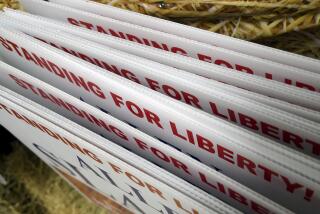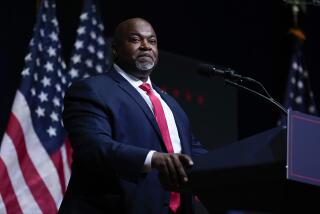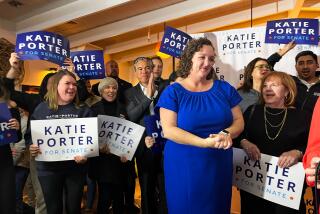The rise and fall of Sarah Palin: A video timeline
- Share via
For the longest time, it ending like this was hard to envision. Not Sarah Palin’s decision to forgo a presidential run. That had long taken on its own kind of inevitability. But that when she finally got around to making her non-candidacy official, there were so many shrugged shoulders and vacant stares.
Much of America, it seemed, even a majority of Republicans, had long moved on.
Still, the decision caused a momentary sensation—a flash of excitement, as if the old Sarah, market-moving Sarah—was back. But the death of Steve Jobs quickly relegated her to a media afterthought, as she had been in recent months. There was some cosmic justice in it all. The woman who had become known for upstaging the political events of her rivals had been stomped on by the biggest of Bigfoots.
By the time Palin certified that she wouldn’t be running in 2012, a poll showed that three-fourths of Republicans didn’t want her in the field. It was a shocking figure, given not only Palin’s profile, but also the persistent dissatisfaction conservatives have had with the current crop of candidates. There had always been a gap between Palin’s media-driven fame and her potential political fortunes, but by the time of her low-key announcement on a conservative radio show, it had widened into a chasm.
Undeniably, a presidential bid had always carried with it its own set of challenges. Even when her political stock was at its zenith, in late 2008, she was viewed by large swaths of Americans as unqualified for high office. And when she resigned as Alaska’s governor in the midst of her first term in 2009, those doubts intensified.
From there, there were high points—her evolving persona as a vanguard of the tea party movement, the role she played in the 2010 midterm elections, the success of her books—and low points, her retreat into social media for long stretches, best exemplified by her “blood libel” response to the Gabrielle Giffords shooting, an attention-grabbing and disruptive summer bus tour that seemed to lack a purpose, and the way her life (sometimes through no fault of her own) resembled a reality TV show, on screen and off.
The cumulative effect of all seemed to damage her in the eyes of all but her most fervent admirers. Where did it all go wrong and how did it unfold? Here’s a look back at some signature moments from Palin’s recent fortunes:
Sept. 3, 2008: Palin’s speech at the GOP convention Her detractors would argue that expectations had been so lowered that all Palin had to do was show up in St. Paul and mount some sort of coherent version of the Republican platform in order to get a passing grade. She did more than that, articulating an anti-elitist line of attack against Barack Obama that would long resonate with the party base. It remains, arguably, her finest hour on the national stage.
Oct. 2, 2008: The wink
The prevailing gossip surrounding Palin’s preparation for her sole debate against Joe Biden had many viewers expecting a train wreck. Instead, she turned in a solid performance, highlighted with some memorable lines. (“Can I call you Joe?”) But all anyone remembers now is how Palin winked at the audience when she spoke of how she had only been part of the campaign for five weeks. Some loved the folksy touch; others recoiled at it.
Nov. 20 2008: A televised turkey execution The election over, Palin returned to Alaska but her knack for making news, good and bad, followed her. An interview granted the day she pardoned a turkey in advance of Thanksgiving was most notable for the fate of other, less fortunate birds in the background of the shot.
July 3, 2009: Palin’s surprise resignation as Alaska governor
The target of multiple state ethics probes and a subject of intense national criticism, Palin unexpectedly walked away from her governorship more than a year early to a more lucrative life of punditry and celebrity. (“I never believed that I nor anyone else needs a title to do this, to make a difference,” she said then, a phrase she would recently repeat.) Many Republicans who supported her still see this as perhaps her biggest mistake, one that may have effectively ended any real chance she had at the presidency.
July 8, 2010: Mama Grizzlies In the midst of the 2010 congressional midterms, Palin kept herself relevant in the political sphere by endorsing several anti-establishment women candidates, while also fully embracing the aims of the growing tea-party movement. While her blessing sometimes tilted a race in her candidate’s favor, it also occasionally lead to disastrous results (Christine O’Donnell) that heightened the schism between Palin and the establishment wing of the party.
Jan. 12, 2011: Blood libel Palin quickly became the focus of attention in the wake of a Tucson, Ariz. gunman’s rampage that critically injured Rep. Gabrielle Giffords because of her use of inflammatory political rhetoric that favored firearm imagery, as well as a map that appeared to be literally targeting vulnerable Democrat congressional incumbents. Palin responded to her attacks by releasing a Facebook video that bitterly denounced her critics while offering nothing by way of conciliation at a time when the nation was looking to heal.
June 2, 2011: Paul Revere’s ride revised After months of keeping a low profile, Palin retook the spotlight with a highly publicized tour of historical sites in the northeastern U.S. Driving up the seaboard in a brightly painted bus, the media in tow, Palin seemed to delight in leaving reporters and supports in the dark about where she would turn up next. But if the concept for the tour was for Palin to refurbish her brand of frontier populism, much of that image-building went out the window once a video of her describing the events of Paul Revere’s ride began making the rounds.
Sept. 3, 2011: Anticlimax in Iowa As Palin continued to delay making a decision about a presidential run, a Labor Day speech to a tea party group in Iowa, three years to the day of her speech at the GOP convention, began to loom as a likely platform for some kind of statement of her intentions. But instead, after threatening to boycott the event altogether, Palin showed up and delivered a speech that echoed the same talking points she had been delivering all year, with no hint about larger plans or a larger vision. She followed that up with a trip to New Hampshire, fueling speculation that she was on the verge of launching a run. But weeks passed with no announcement.
Now, it appears that run isn’t going to happen, although with Sarah Palin, saying never is a hazardous occupation. But she has said definitively that she won’t be a GOP candidate, or a third party candidate, for the presidency in 2012. And if a Republican captures the White House next year, it likely dims Palin’s chances until the next decade and quite likely forever.
She’ll remain famous regardless, with a diehard, passionate group of supporters who will defend her to the end. That may have to be enough.
More to Read
Get the L.A. Times Politics newsletter
Deeply reported insights into legislation, politics and policy from Sacramento, Washington and beyond. In your inbox three times per week.
You may occasionally receive promotional content from the Los Angeles Times.










